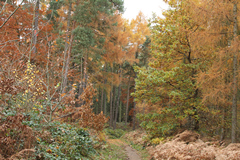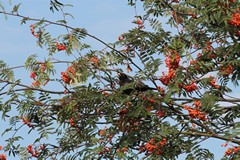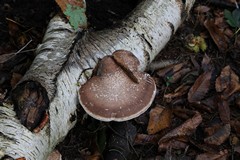
The rich colours of Autumn leaves
British woodland has many different appearances, depending on where it is and what time of year it
is.
Many of the broadleaved species are at their most beautiful in the Autumn, as they prepare to drop their leaves by extracting the useful chemicals in them and causing them turn turn brilliant yellows, oranges and reds. Much of the red colour is caused by sugars.
Britain has only 12% woodland cover as compared with the rest of Europe which has 44%. However we are home to 80% of the most ancient trees in Europe.
The oldest tree in the British Isles is thought to be the Fortingall yew in Scotland, which is 5,000 years old. An 800-year-old Oak in Sherwood forest, known as the Major oak, is closely associated with the tales of Robin Hood and his merry men.
There are 50 species of native trees and shrubs and 3 native conifers and a further 46 species that have gone extinct in the UK in the last 100 years.

Blackbird enjoying the rowan berries
The majority of British broadleaved trees are wind pollinated. This group includes alder, ssh, beech, birch, elm, hazel, hornbeam, oak, poplar, plane, walnut and some varieties of willow. Insect pollinated trees include box, elder, holly, horse-chestnut, lime, and maple
Woodland performs many vital functions. Woodland stabilises soil, generates oxygen, stores carbon, provides homes for many plants and animals, and provides fuel and raw materials, as well as having a high recreational value.
Woodland is classed as low density forest with open habitats and plenty of sunlight reaching the ground. There are many beautiful and often quite tiny flowers to be found in these areas, especially in Spring. There are also fantastic Fungi particularly in Autumn.
Woodlands in Britain have been around since the end of the last Ice age 13000 years ago. Wind and animal born seeds colonised the country from the Southeast as the Ice retreated.
Cold tolerant trees such as aspen and birch were first, followed by pine, hazel, alder and oak, then elm and lime and last ash, hornbeam and maple.
By 4000 years ago the Wildwood was fully developed. Wildwood means it developed without any human influence.

Birch polypore
A lot of woodland disappeared due to clearance for farming and fuel by the time the Domesday book was written in 1086. What remained was used as wood pasture by pigs sheep and cattle.
The woods were often coppiced to ensure a self sustaining supply of trees.
Different trees prefer different soils. Oaks prefer heavy wet soils. Lime and ash like limestone areas and beech is happy on calcareous or acidic soils.
Threats to woodland include, brambles and bracken, which can establish so fast in open areas that they choke off the light to tree seedlings, and the spread of the muntjac deer which can heavily overbrowse everything from the floor up to about three feet off the gound. This depletes the undergrowth and shrubs needed by animals such as the nightingale and the dormouse.